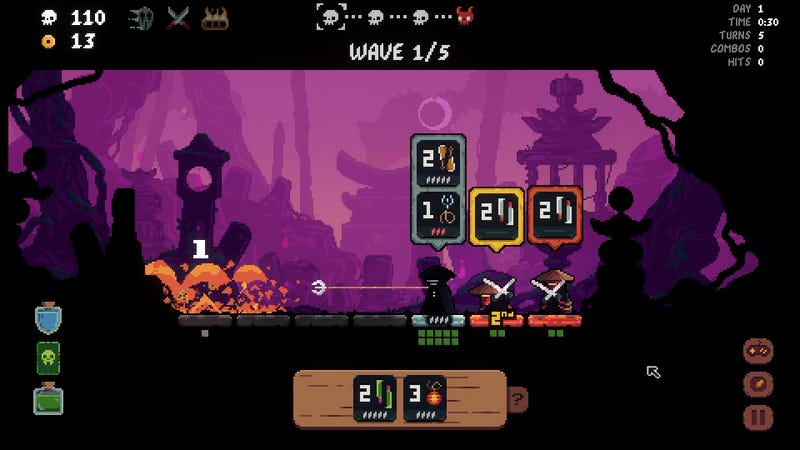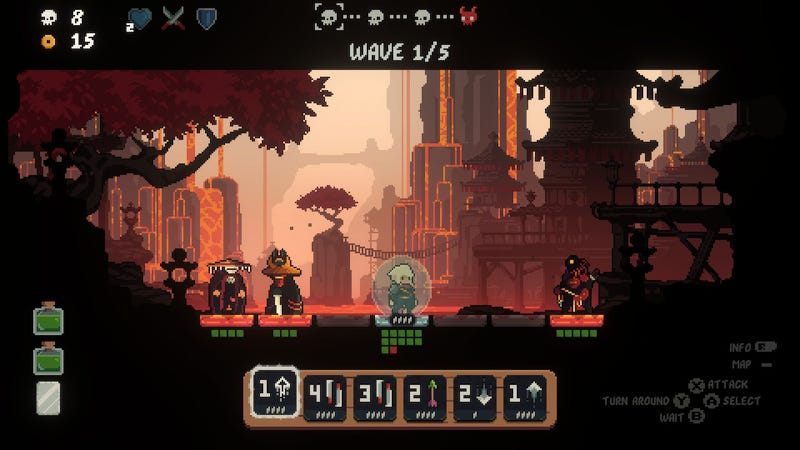My first mistake was rushing in. Shogun Showdown is a game about planning and patience. Things can go from bad to dead in just a few turns. Unless you take a step back and try to see the larger picture, it can feel like an overly simplistic and needlessly punishing experience. My first, brief sessions with Shogun Showdown spread over a few different nights felt like homework and I am increasingly feeling too old for that shit. But I stuck with it and eventually wrapped my head around its elegant mechanics. When Shogun Showdown finally clicks into place it’s excellent.
The game came out of Early Access and arrived on PlayStation, Xbox, Switch, and PC last month from the small indie dev Roboatino and it’s an incredibly clever mashup of genre bests like Slay the Spire and Into the Breach (I’ve played 4-5 hours on Nintendo’s handheld where it’s snappy and vibrant). Your goal is to defeat the evil shogun, but to do that you need to overcome a series of increasingly difficult stages where turn-based combat plays out across a tiny side-scrolling 2D battlefield of less than a dozen spaces. Enemies come at you in waves, and once you’ve completed each of the fights you move onto the next node on the world map.

The action hinges on unique abilities, items, and cards you accrue over the course of the journey. Simple sword cards let you deal damage to whatever’s in front of you. A bow will let you hit a target at long range. More sophisticated cards include lightning bolts that only hit the last enemy in the row or forward dashes that let you move behind enemy lines. A small apothecary of healing potions, magic shields, and other consumables give you additional options to strategize around. After successful battles and at rest stop shops you can buy more stuff or upgrade the things you already have.
But the real thing that makes Shogun Showdown feel so unique and fun is the way it forces you to manage space and plan ahead by telegraphing what’s coming. The starting Wanderer class (additional classes with different starting cards and perks are unlocked the more you play) can move past an opponent once every four turns. When an enemy is preparing to attack you can scoot past them and dodge the move entirely before killing them behind. Towards the end of a run, a combo of forward dashes, back steps, and other maneuvers that double as attacks let you control the battlefield like a master swordsman, at once deadly and untouchable.

Where games like Slay the Spire have you trying to craft builds that maximize damage output and Into the Breach rewards you for intricate planning, Shogun Showdown blends these incentives in a way that feels streamlined yet still varied and challenging. I also enjoy the lack of RNG. Your attacks never miss and you don’t have to worry about drawing the wrong card at the worst time. The result is a satisfying mix of player empowerment and mechanical limitations. There’s nothing better than stacking the perfect set of moves together and then watching the dominoes fall and clear the battlefield in a single turn.
I’ve only beaten the game once so far, and I immediately wanted to go back and explore new classes and deck strategies. Beyond that I can’t speak to the long-term replayability when it comes to the roguelike nature of unlocks, hidden secrets, or potential extra challenges. The bones of Shogun Showdown are great though, made all the easier to recommend thanks to the slick pixel art animations and rock-infused, chiptune-y soundtrack. And for now there’s plenty more cards I want to discover and experiment with.

Leave a Reply